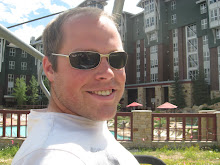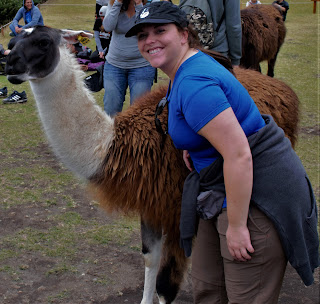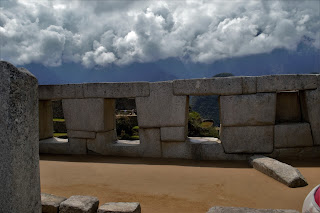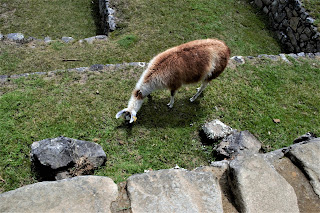This is a picture of the second hotel we stayed at in Peru, located in the Sacred Valley. It was beautiful. We spent the whole previous day flying from Salt Lake City to Atlanta, and then from Atlanta to Lima, Peru and that morning flying from Lima to Cuzco. In Cuzco we were met by a local travel agency Condor Travel, who we highly recommend if you are ever traveling in South America! They grabbed our bags and took us in a car from the airport and through Cuzco to this hotel.
The balcony of our hotel in the Sacred Valley
The walkways of the hotel at the Sacred Valley
A pizzeria at the hotel in Sacred Valley. The sweater Chris is wearing was hand-made by a local Peruvian woman out of alpaca and sold to him at a market outside our hotel. Our waiter was able to recognize the family who made the sweater based on the knitting.
The next day a driver picked us up and drove us from the Sacred Valley to Ollantaytambo where we got on a train which took us to Aguas Calientes, otherwise known as the Machu Picchu Pueblo, a town which is a 25-minute bus ride from the Machu Picchu ruins.
Aguas Calientes had a beautiful view of the mountains.
To get to the Machu Picchu ruins, we took a 25-minute bus ride up a very steep and very windy mountain. It was a pretty sketchy situation with lots of buses going back and forth constantly. It didn't seems like these buses should be able to take the curves it was, but we made it up and down twice safe and sound. Apparently there is no history of any bus wrecks, only rock slides.
We had a Peruvian tour guide from Condor Travel named Percy who lead us through the ruins and told us about each point.
There were lots of places to stop and take pictures. There were a few people in our tour group and we'd take turns taking each other's pictures. There were people from all over the world there to see Machu Picchu, one of the modern seven wonders of the world.
There were llamas everywhere. The llamas at Machu Picchu had more privileges than the people, as they were allowed to go in more areas than we were. They were very tame and used to posing for pictures.
The inside of a guard house. The roof is modern, and they replace it every year. They have fashioned it in a way they believe the Incans would have.
This is a ceremonial rock. They believe that sacrifices were done on this rock, and the point on the rock is because the rock was carved to look like a mountain. Rocks are carved to look like mountains in several places in Machu Picchu. This rock was blocked off so no one could climb on it, which was super annoying to me.
You'll see this guy's head in a lot of pictures. He was in our group, and he was always in the way.
Another side of the ruins. All these terraces had a couple of functions. They helped with the landslide issue in the rainy season, and they also provided a flat surface for planting food.
Our tour guide talked about this rock house for a minute to describe the difference between the Incans back than and us now. If we want to build a house in a certain spot and there is a big rock in the way, we can have the rock moved. But the Incans didn't have the tools to have a big rock like that moved, so instead they built a house around the rock.
This is a picture of the Sun Temple of Macchu Picchu, which as you can see by the glass covering to the right, they are still excavating. On June 21st each year, which is a holy day, the sun aligns through that window.
All this green grassy area was off limits to us, which is probably why it looks so nice. They think this area may have been like a marketplace or another kind of gathering place. It was beautiful.
These pictures show the notches on some of the blocks the Incans made. Sometimes these were there to support roof beams that are no longer there and sometimes they are kind of like lego pieces to fit into another block on a building that was left unfinished.
Temple of the Three Windows
Our tour guide has us stop right here and feel the blocks to feel how smooth they are and to see if we could fit our fingers between the blocks. The Incans had no tools to cut these blocks, yet they are perfectly smooth and tight fighting and require no mortar to stay together. To this day, no one knows for sure how the Incans were able to accomplish this. Aliens?
A mama llama and her new baby at the entrance to Huayna Picchu. Huayna Picchu means "Young Mountain" in the old Incan language of Quechua. We were originally going to hike this mountain, but they only allow 400 people to hike it per day as it is extremely steep, narrow, and dangerous. We didn't get tickets early enough. Hiking Machu Picchu was hard enough, as you'll see, so we ended up being glad.
These pools of water were pretty cool. Workers bring cups of water to fill these every morning. The one on the right is used to see the reflection of the sun, and the one on the left is used to see the reflection of the moon at night. They believe this was used in some sort of ceremony that shamans would take part in. They think it was maybe some way to communicate with the gods or extraterrestrials. The picture below shows the reflection of the sun while we were there. Not many tourists get to see the reflection of the moon.
This is the Condor Rock, because it looks like a Condor. The condor was sacred to the Incans and is part of the Incan trilogy which includes the Condor, the Puma, and the Snake. The Condor represents the sky, where the rains fall and provides for the crops. The Puma represents the land, which provides the crops. The Snake represents the river that flows through Machu Picchu, called Urubamba, and all together they represent Machu Picchu.
This rock was pretty awesome. It is suspended in the air and has been for years, and no one knows when it will fall. There is a room underneath that they used to let tourists go under and explore and you could take pictures pretending you were holding the rock, but they don't let you anymore. Not because they are afraid the rock is going to fall on you, but because too many tourists have left trash in the room underneath. This made me upset, because I love rocks and exploring on and under them. The trash everywhere really upset me and Chris. People all over the world travel to see one of the wonders of the world, yet do not have the respect to keep it clean. It did make us more appreciative of the clean surroundings we enjoy in Utah.
This is on our second day at Machu Picchu. We weren't with a tour group on this day, instead we hiked Machu Picchu. In Quechua, it means "Old Mountain." We originally hoped to hike Huayna Picchu, just because reading about it sounds a little more exciting and exclusive since they only let 400 people per day do it. Huayna Picchu is supposed to be a shorter hike than Machu Picchu, but much steeper. From what we read, Machu Picchu was a longer hike, but not as steep. It is certainly higher than Huayna Picchu, but we didn't expect it to be as difficult as it was, and we had no idea that is was going to be 100% stairs. Big stairs. Bigger than my short stubby legs are supposed to be able to climb. This picture above shows us a little after we started with the ruins in the distance. Our faces are all sweaty because we were wearing so much sun block and insect repellent.
Us at the top. We were very happy to make it. At the entrance gate we had to sign in so that the Machu Picchu employees could keep track of everyone on the mountain. They told us it should take 2 hours to get up and 1 to get down. There were some people zooming up the mountain, but we took our time, our legs needed it.
View of the ruins from the top.
Resting area at the top. People from all over the world were there. We met some people from Michigan and a boy from Ecuador.
The view was breathtaking. Despite the pain in getting there and the pain to come going down, it was all worth it, and I'd do it again in a heartbeat.
A fun gateway near the top. We took our time coming down and took some pictures.
As difficult as it was going up the stairs, going down was even more difficult. The stairs were large and steep. Chris took pictures of them to show how hard they were to climb, but I feel like the pictures don't give them justice. Despite having trained all summer for this hike, my legs were not prepared. I should have just used a StairMaster all summer rather than spending my time in the mountains trail running.
This was a fun area by the stairs near the top. We didn't have a tour guide, but I imagine someone must have been stationed here back in the days of the Incas.
I love climbing on rocks.
There was a couple of llamas greeting us at the bottom of the mountain, so of course we got our picture taken with one of them.
I think this is my favorite picture. This is a side of the ruins that I feel like is not shown as often. I think it is beautiful. It shows all these beautiful green terraces on the other side.
There is a bunch of dirt on my arm because I took a stumble down the stairs at the bottom of the hike. Luckily I caught myself before tumbling down the cliff next to me. I believe I mumbled to myself "freaking Incan stairs" more than once during our trip.
This area is actually right in front of the trail to the Incan Bridge. Our tour guide had mentioned it briefly the day before, and I knew I wanted to see it. However, the stairs we saw leading to the bridge looked very similar to all the stairs we just finished climbing, and our legs were pretty done. We were sitting there enjoying the view when a couple from Canada walked by having just finished the Incan Bridge trail. They told us it was a 20-minute hike that was super easy. Additionally, they had hiked Huayna Picchu that morning, so if they could do it, we could too. Their hike up to Huayna Picchu was pretty brutal; they were climbing on all fours at some parts. Once they were at the top, they were not impressed with the view. They said that the view people come to see is the view from Machu Picchu, not the view from Huayna Picchu. We were really glad to have had that perspective from them. We had been disappointed not to have had the chance to hike Huayna Picchu, but after talking to them, it sounds like we ended up with the better hike.
The couple from Canada turned out to be right - the hike to see the Incan Bridge was very easy. It was very nice on our sore legs. The Incan Bridge itself was not that impressive. We got there at the same time as another group, and all the reactions to the bridge were pretty funny. No one really knew what to expect, but I guess we expected something bigger? I kind of thought we would be walking across the actual Incan Bridge.
There is a gate in the picture that blocks off access to the actual Incan Bridge. The pathway to the gate was pretty narrow and there was a railing provided. It was sheer death on one side if you fell. Just a little bit beyond the gate is a wooden bridge that has been there since the Incan times. A tour guide I talked to later postured that it may have been an escape route at one time.
After our visit to the Incan Bridge, we decided to head back. The trails at the ruins are one way, so it's kind of like walking through an Ikea. You start at the beginning and you have to go all the way through. Our legs were jello, and we saw a shortcut to the exit which was by walking down all these terraces. I remembered seeing the shortcut the day before on our tour and thinking it looked fun to walk down. But it was actually very painful after that day's hike!
This was the end of our time at Machu Picchu. It was a beautiful and unforgettable experience. We hope to come again someday.




























































































No comments:
Post a Comment